Product and Service Innovation at W.L. Gore & Associates
VerifiedAdded on 2023/04/25
|6
|1796
|304
AI Summary
This case talks about Gore-Tex and W.L. Gore & Associates, which is an innovative organization and is responsible for popular products as Gore-Tex fabric. In the following, an effort has been made to discuss the innovation process and its strategies to attain success in the market.
Contribute Materials
Your contribution can guide someone’s learning journey. Share your
documents today.
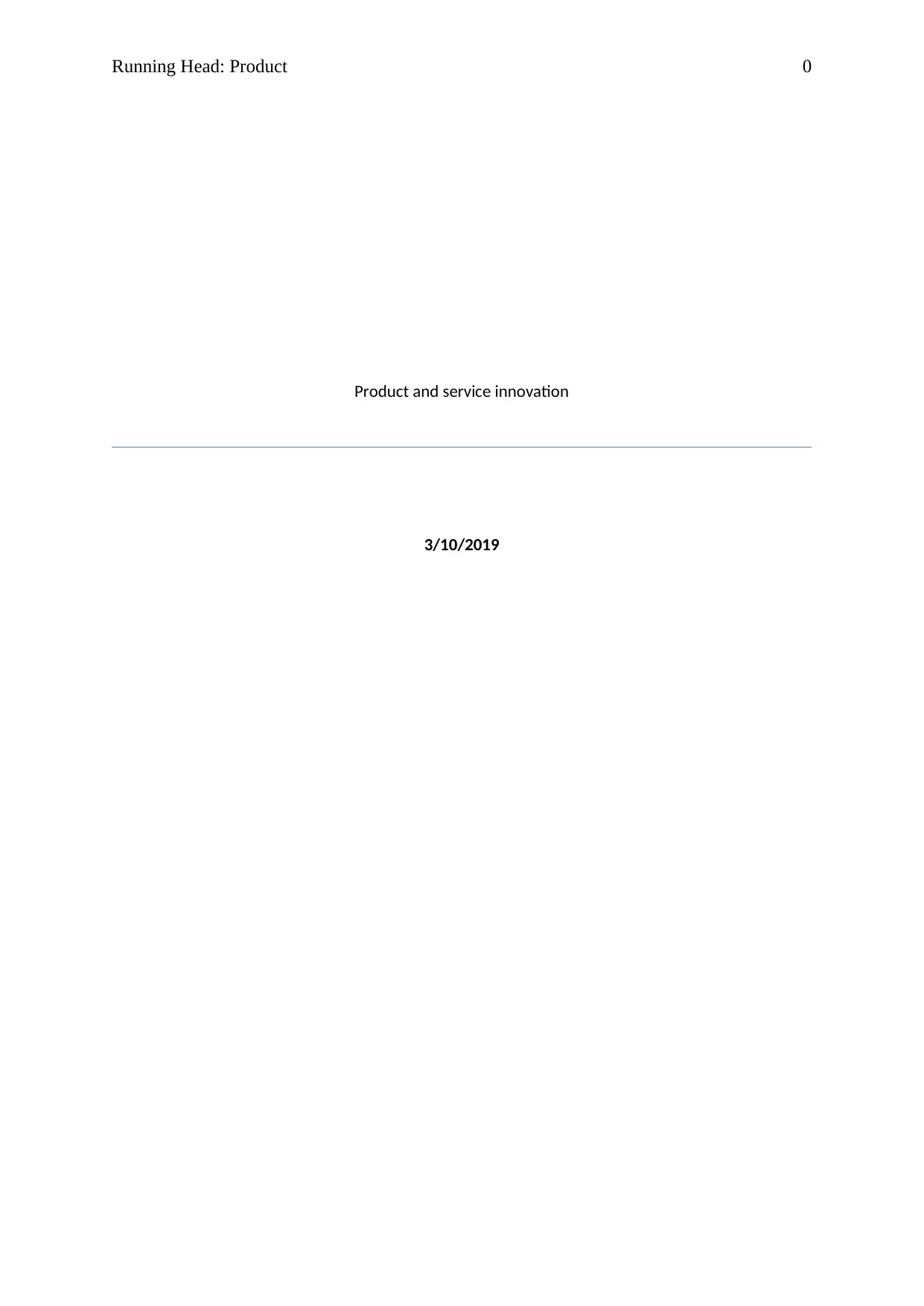
Running Head: Product 0
Product and service innovation
3/10/2019
Product and service innovation
3/10/2019
Secure Best Marks with AI Grader
Need help grading? Try our AI Grader for instant feedback on your assignments.
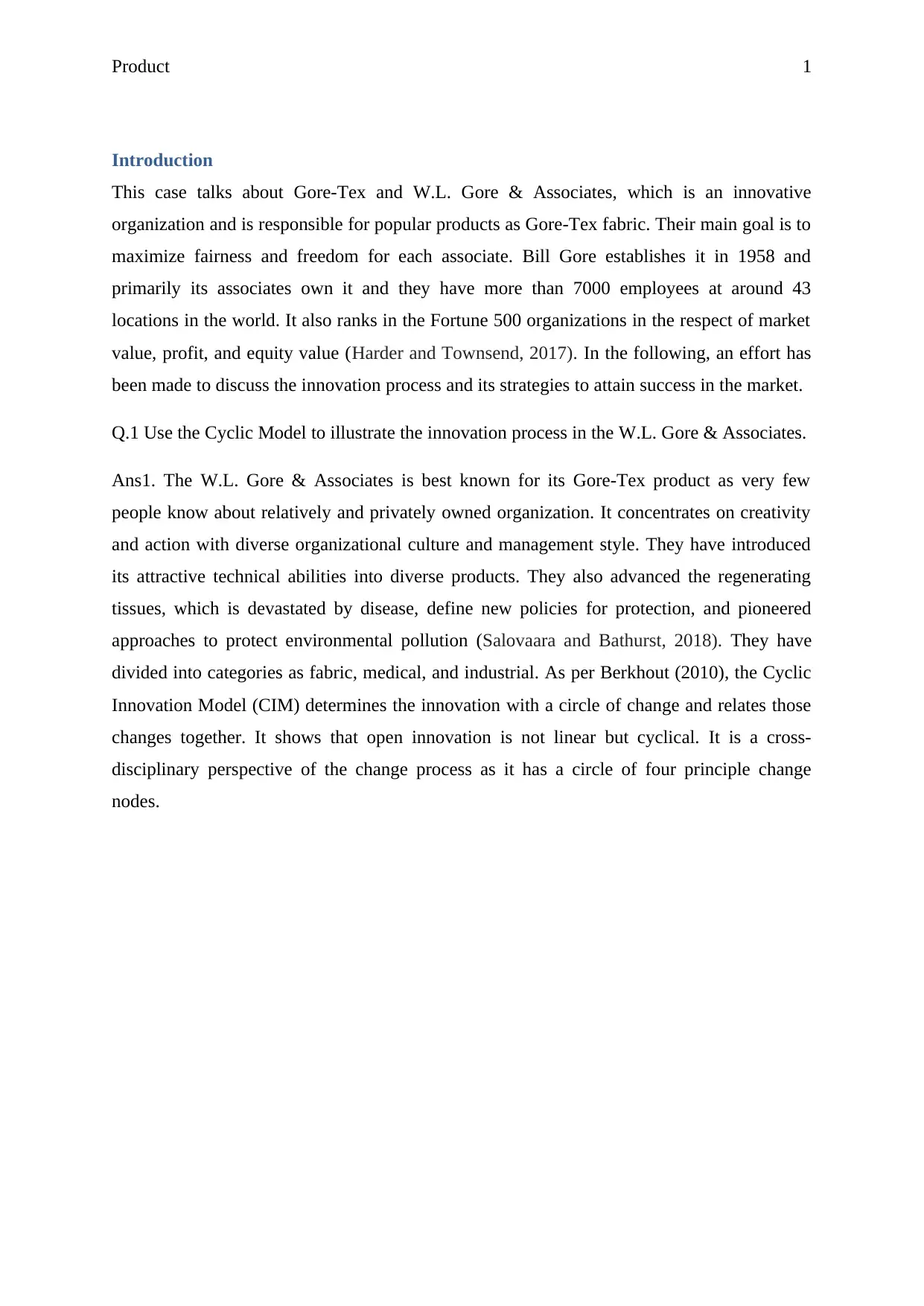
Product 1
Introduction
This case talks about Gore-Tex and W.L. Gore & Associates, which is an innovative
organization and is responsible for popular products as Gore-Tex fabric. Their main goal is to
maximize fairness and freedom for each associate. Bill Gore establishes it in 1958 and
primarily its associates own it and they have more than 7000 employees at around 43
locations in the world. It also ranks in the Fortune 500 organizations in the respect of market
value, profit, and equity value (Harder and Townsend, 2017). In the following, an effort has
been made to discuss the innovation process and its strategies to attain success in the market.
Q.1 Use the Cyclic Model to illustrate the innovation process in the W.L. Gore & Associates.
Ans1. The W.L. Gore & Associates is best known for its Gore-Tex product as very few
people know about relatively and privately owned organization. It concentrates on creativity
and action with diverse organizational culture and management style. They have introduced
its attractive technical abilities into diverse products. They also advanced the regenerating
tissues, which is devastated by disease, define new policies for protection, and pioneered
approaches to protect environmental pollution (Salovaara and Bathurst, 2018). They have
divided into categories as fabric, medical, and industrial. As per Berkhout (2010), the Cyclic
Innovation Model (CIM) determines the innovation with a circle of change and relates those
changes together. It shows that open innovation is not linear but cyclical. It is a cross-
disciplinary perspective of the change process as it has a circle of four principle change
nodes.
Introduction
This case talks about Gore-Tex and W.L. Gore & Associates, which is an innovative
organization and is responsible for popular products as Gore-Tex fabric. Their main goal is to
maximize fairness and freedom for each associate. Bill Gore establishes it in 1958 and
primarily its associates own it and they have more than 7000 employees at around 43
locations in the world. It also ranks in the Fortune 500 organizations in the respect of market
value, profit, and equity value (Harder and Townsend, 2017). In the following, an effort has
been made to discuss the innovation process and its strategies to attain success in the market.
Q.1 Use the Cyclic Model to illustrate the innovation process in the W.L. Gore & Associates.
Ans1. The W.L. Gore & Associates is best known for its Gore-Tex product as very few
people know about relatively and privately owned organization. It concentrates on creativity
and action with diverse organizational culture and management style. They have introduced
its attractive technical abilities into diverse products. They also advanced the regenerating
tissues, which is devastated by disease, define new policies for protection, and pioneered
approaches to protect environmental pollution (Salovaara and Bathurst, 2018). They have
divided into categories as fabric, medical, and industrial. As per Berkhout (2010), the Cyclic
Innovation Model (CIM) determines the innovation with a circle of change and relates those
changes together. It shows that open innovation is not linear but cyclical. It is a cross-
disciplinary perspective of the change process as it has a circle of four principle change
nodes.
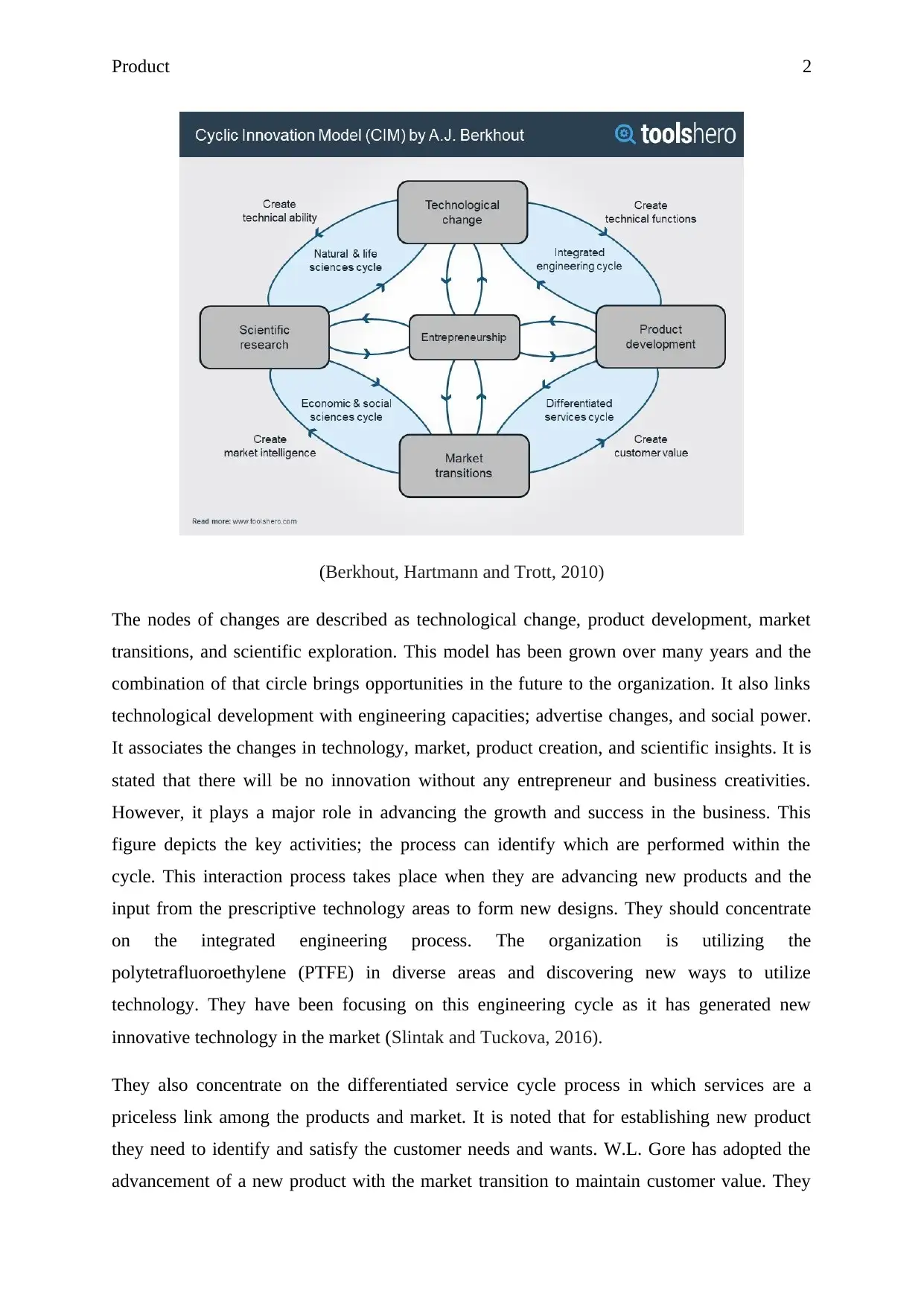
Product 2
(Berkhout, Hartmann and Trott, 2010)
The nodes of changes are described as technological change, product development, market
transitions, and scientific exploration. This model has been grown over many years and the
combination of that circle brings opportunities in the future to the organization. It also links
technological development with engineering capacities; advertise changes, and social power.
It associates the changes in technology, market, product creation, and scientific insights. It is
stated that there will be no innovation without any entrepreneur and business creativities.
However, it plays a major role in advancing the growth and success in the business. This
figure depicts the key activities; the process can identify which are performed within the
cycle. This interaction process takes place when they are advancing new products and the
input from the prescriptive technology areas to form new designs. They should concentrate
on the integrated engineering process. The organization is utilizing the
polytetrafluoroethylene (PTFE) in diverse areas and discovering new ways to utilize
technology. They have been focusing on this engineering cycle as it has generated new
innovative technology in the market (Slintak and Tuckova, 2016).
They also concentrate on the differentiated service cycle process in which services are a
priceless link among the products and market. It is noted that for establishing new product
they need to identify and satisfy the customer needs and wants. W.L. Gore has adopted the
advancement of a new product with the market transition to maintain customer value. They
(Berkhout, Hartmann and Trott, 2010)
The nodes of changes are described as technological change, product development, market
transitions, and scientific exploration. This model has been grown over many years and the
combination of that circle brings opportunities in the future to the organization. It also links
technological development with engineering capacities; advertise changes, and social power.
It associates the changes in technology, market, product creation, and scientific insights. It is
stated that there will be no innovation without any entrepreneur and business creativities.
However, it plays a major role in advancing the growth and success in the business. This
figure depicts the key activities; the process can identify which are performed within the
cycle. This interaction process takes place when they are advancing new products and the
input from the prescriptive technology areas to form new designs. They should concentrate
on the integrated engineering process. The organization is utilizing the
polytetrafluoroethylene (PTFE) in diverse areas and discovering new ways to utilize
technology. They have been focusing on this engineering cycle as it has generated new
innovative technology in the market (Slintak and Tuckova, 2016).
They also concentrate on the differentiated service cycle process in which services are a
priceless link among the products and market. It is noted that for establishing new product
they need to identify and satisfy the customer needs and wants. W.L. Gore has adopted the
advancement of a new product with the market transition to maintain customer value. They
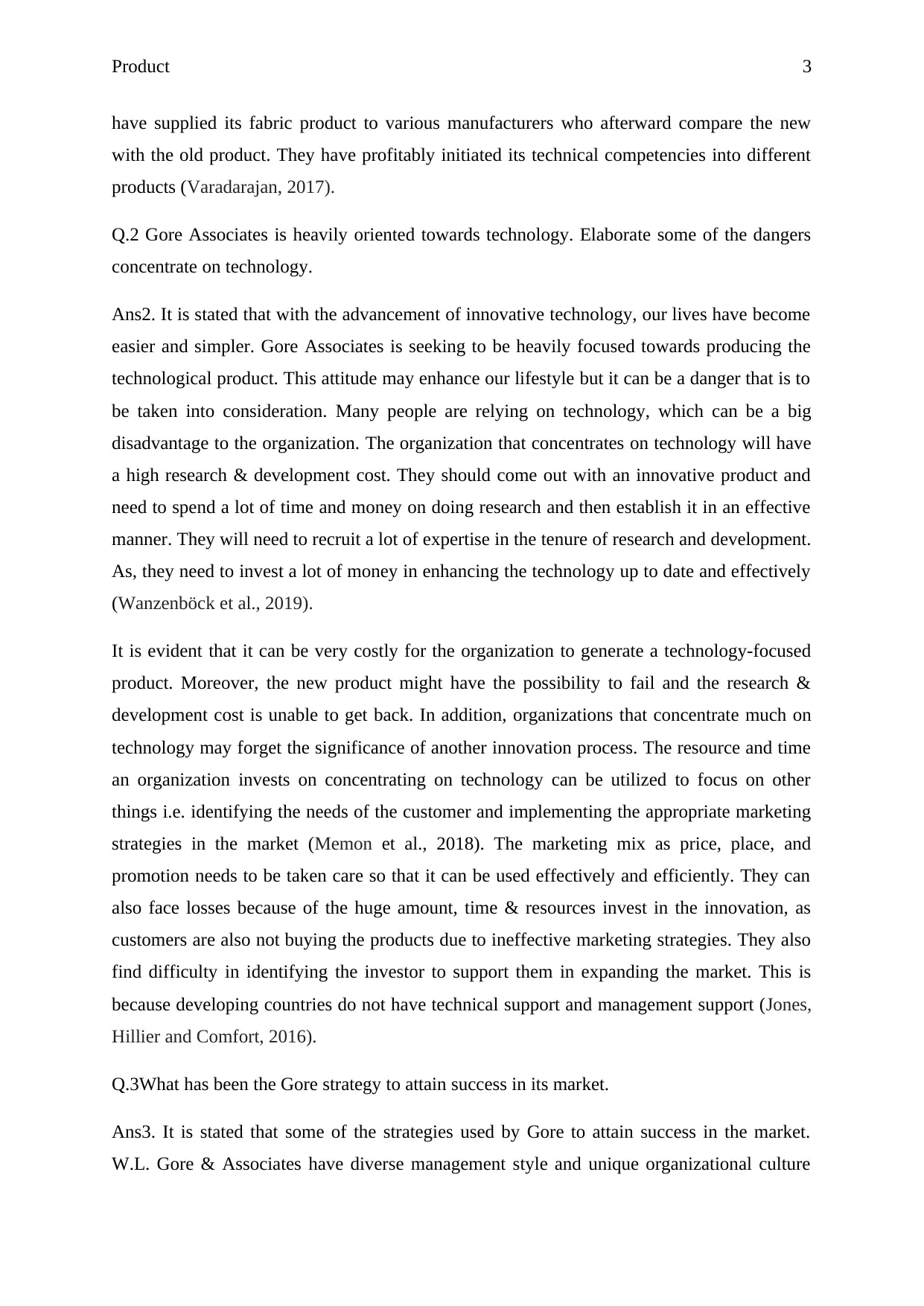
Product 3
have supplied its fabric product to various manufacturers who afterward compare the new
with the old product. They have profitably initiated its technical competencies into different
products (Varadarajan, 2017).
Q.2 Gore Associates is heavily oriented towards technology. Elaborate some of the dangers
concentrate on technology.
Ans2. It is stated that with the advancement of innovative technology, our lives have become
easier and simpler. Gore Associates is seeking to be heavily focused towards producing the
technological product. This attitude may enhance our lifestyle but it can be a danger that is to
be taken into consideration. Many people are relying on technology, which can be a big
disadvantage to the organization. The organization that concentrates on technology will have
a high research & development cost. They should come out with an innovative product and
need to spend a lot of time and money on doing research and then establish it in an effective
manner. They will need to recruit a lot of expertise in the tenure of research and development.
As, they need to invest a lot of money in enhancing the technology up to date and effectively
(Wanzenböck et al., 2019).
It is evident that it can be very costly for the organization to generate a technology-focused
product. Moreover, the new product might have the possibility to fail and the research &
development cost is unable to get back. In addition, organizations that concentrate much on
technology may forget the significance of another innovation process. The resource and time
an organization invests on concentrating on technology can be utilized to focus on other
things i.e. identifying the needs of the customer and implementing the appropriate marketing
strategies in the market (Memon et al., 2018). The marketing mix as price, place, and
promotion needs to be taken care so that it can be used effectively and efficiently. They can
also face losses because of the huge amount, time & resources invest in the innovation, as
customers are also not buying the products due to ineffective marketing strategies. They also
find difficulty in identifying the investor to support them in expanding the market. This is
because developing countries do not have technical support and management support (Jones,
Hillier and Comfort, 2016).
Q.3What has been the Gore strategy to attain success in its market.
Ans3. It is stated that some of the strategies used by Gore to attain success in the market.
W.L. Gore & Associates have diverse management style and unique organizational culture
have supplied its fabric product to various manufacturers who afterward compare the new
with the old product. They have profitably initiated its technical competencies into different
products (Varadarajan, 2017).
Q.2 Gore Associates is heavily oriented towards technology. Elaborate some of the dangers
concentrate on technology.
Ans2. It is stated that with the advancement of innovative technology, our lives have become
easier and simpler. Gore Associates is seeking to be heavily focused towards producing the
technological product. This attitude may enhance our lifestyle but it can be a danger that is to
be taken into consideration. Many people are relying on technology, which can be a big
disadvantage to the organization. The organization that concentrates on technology will have
a high research & development cost. They should come out with an innovative product and
need to spend a lot of time and money on doing research and then establish it in an effective
manner. They will need to recruit a lot of expertise in the tenure of research and development.
As, they need to invest a lot of money in enhancing the technology up to date and effectively
(Wanzenböck et al., 2019).
It is evident that it can be very costly for the organization to generate a technology-focused
product. Moreover, the new product might have the possibility to fail and the research &
development cost is unable to get back. In addition, organizations that concentrate much on
technology may forget the significance of another innovation process. The resource and time
an organization invests on concentrating on technology can be utilized to focus on other
things i.e. identifying the needs of the customer and implementing the appropriate marketing
strategies in the market (Memon et al., 2018). The marketing mix as price, place, and
promotion needs to be taken care so that it can be used effectively and efficiently. They can
also face losses because of the huge amount, time & resources invest in the innovation, as
customers are also not buying the products due to ineffective marketing strategies. They also
find difficulty in identifying the investor to support them in expanding the market. This is
because developing countries do not have technical support and management support (Jones,
Hillier and Comfort, 2016).
Q.3What has been the Gore strategy to attain success in its market.
Ans3. It is stated that some of the strategies used by Gore to attain success in the market.
W.L. Gore & Associates have diverse management style and unique organizational culture
Secure Best Marks with AI Grader
Need help grading? Try our AI Grader for instant feedback on your assignments.
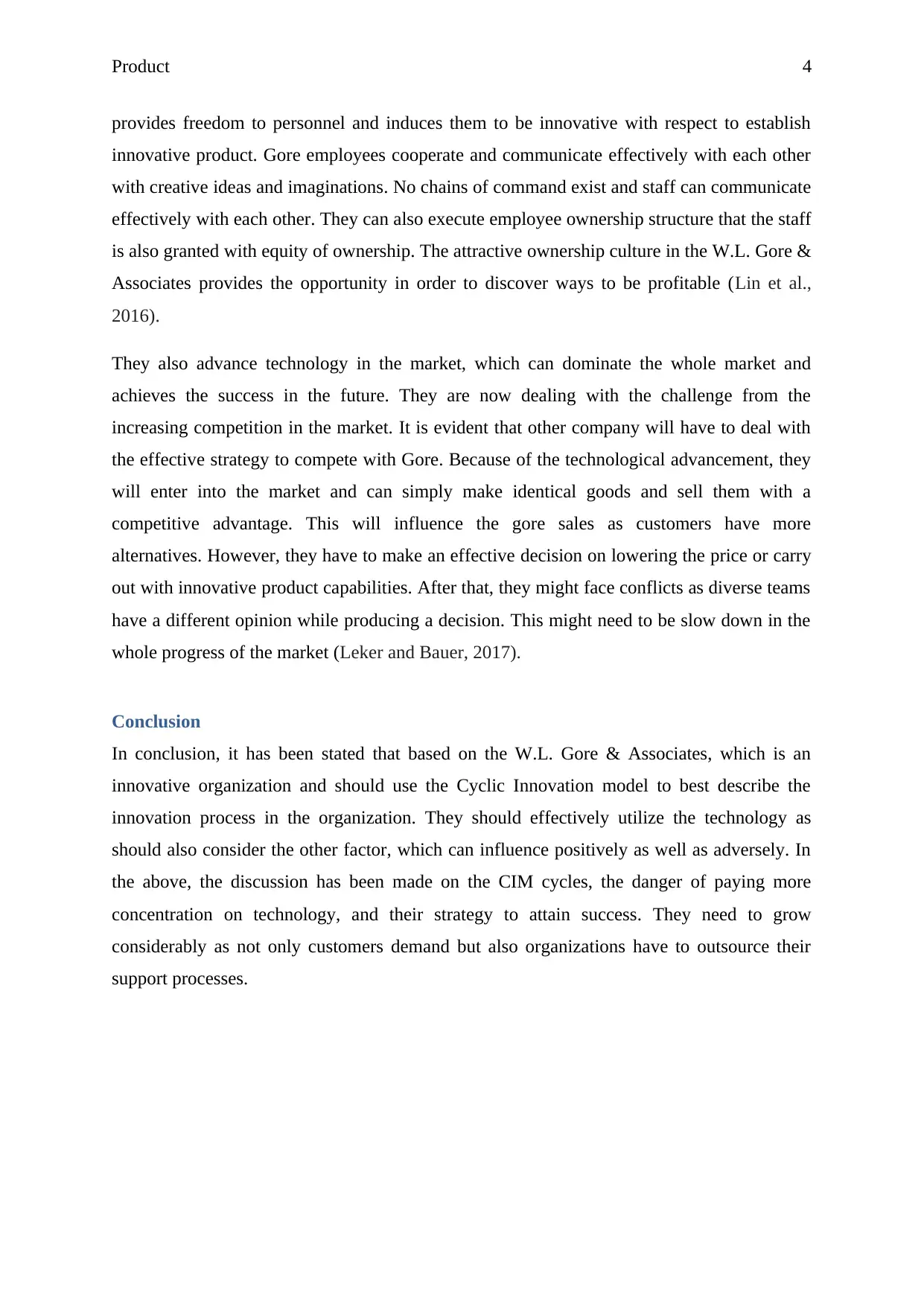
Product 4
provides freedom to personnel and induces them to be innovative with respect to establish
innovative product. Gore employees cooperate and communicate effectively with each other
with creative ideas and imaginations. No chains of command exist and staff can communicate
effectively with each other. They can also execute employee ownership structure that the staff
is also granted with equity of ownership. The attractive ownership culture in the W.L. Gore &
Associates provides the opportunity in order to discover ways to be profitable (Lin et al.,
2016).
They also advance technology in the market, which can dominate the whole market and
achieves the success in the future. They are now dealing with the challenge from the
increasing competition in the market. It is evident that other company will have to deal with
the effective strategy to compete with Gore. Because of the technological advancement, they
will enter into the market and can simply make identical goods and sell them with a
competitive advantage. This will influence the gore sales as customers have more
alternatives. However, they have to make an effective decision on lowering the price or carry
out with innovative product capabilities. After that, they might face conflicts as diverse teams
have a different opinion while producing a decision. This might need to be slow down in the
whole progress of the market (Leker and Bauer, 2017).
Conclusion
In conclusion, it has been stated that based on the W.L. Gore & Associates, which is an
innovative organization and should use the Cyclic Innovation model to best describe the
innovation process in the organization. They should effectively utilize the technology as
should also consider the other factor, which can influence positively as well as adversely. In
the above, the discussion has been made on the CIM cycles, the danger of paying more
concentration on technology, and their strategy to attain success. They need to grow
considerably as not only customers demand but also organizations have to outsource their
support processes.
provides freedom to personnel and induces them to be innovative with respect to establish
innovative product. Gore employees cooperate and communicate effectively with each other
with creative ideas and imaginations. No chains of command exist and staff can communicate
effectively with each other. They can also execute employee ownership structure that the staff
is also granted with equity of ownership. The attractive ownership culture in the W.L. Gore &
Associates provides the opportunity in order to discover ways to be profitable (Lin et al.,
2016).
They also advance technology in the market, which can dominate the whole market and
achieves the success in the future. They are now dealing with the challenge from the
increasing competition in the market. It is evident that other company will have to deal with
the effective strategy to compete with Gore. Because of the technological advancement, they
will enter into the market and can simply make identical goods and sell them with a
competitive advantage. This will influence the gore sales as customers have more
alternatives. However, they have to make an effective decision on lowering the price or carry
out with innovative product capabilities. After that, they might face conflicts as diverse teams
have a different opinion while producing a decision. This might need to be slow down in the
whole progress of the market (Leker and Bauer, 2017).
Conclusion
In conclusion, it has been stated that based on the W.L. Gore & Associates, which is an
innovative organization and should use the Cyclic Innovation model to best describe the
innovation process in the organization. They should effectively utilize the technology as
should also consider the other factor, which can influence positively as well as adversely. In
the above, the discussion has been made on the CIM cycles, the danger of paying more
concentration on technology, and their strategy to attain success. They need to grow
considerably as not only customers demand but also organizations have to outsource their
support processes.
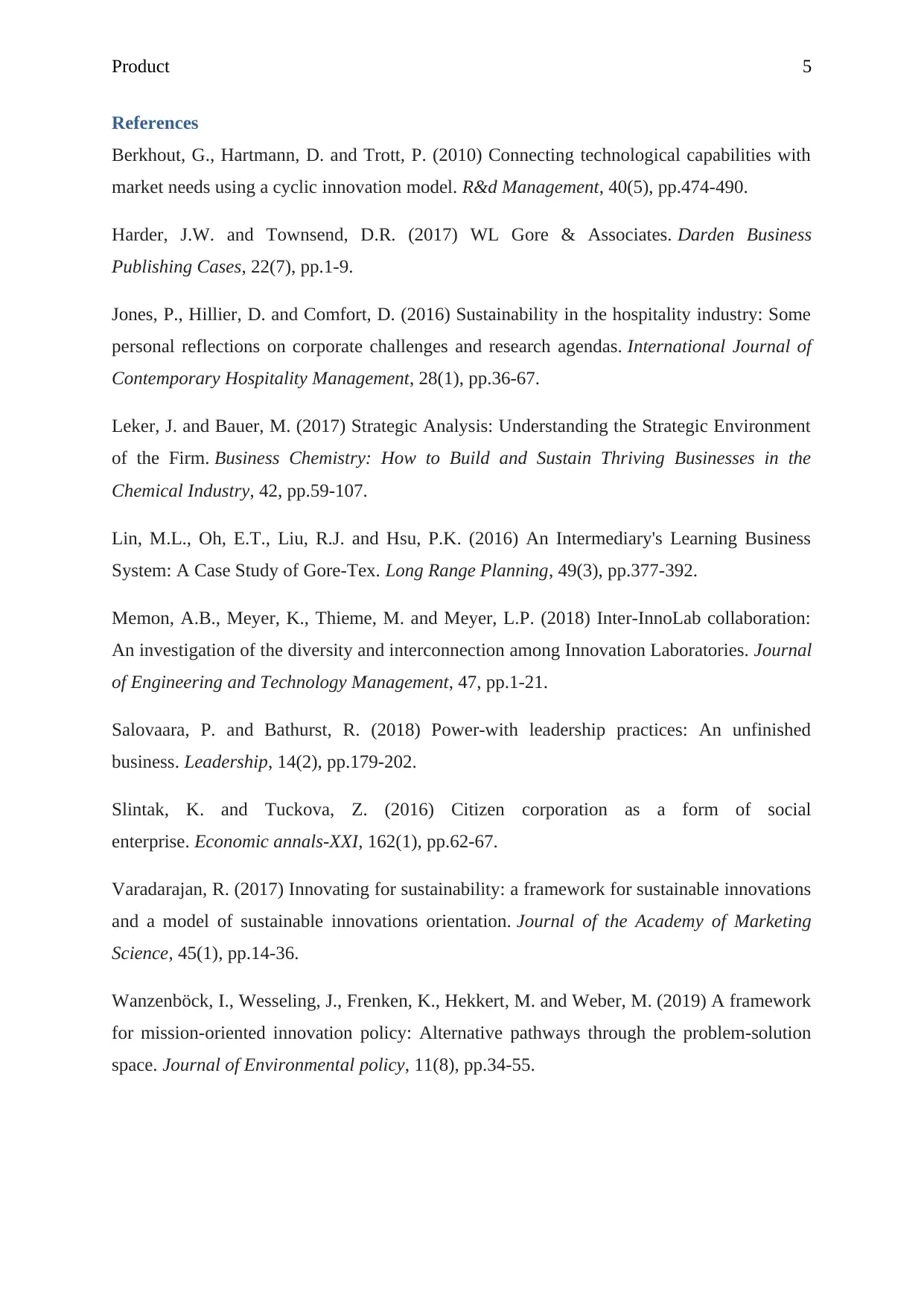
Product 5
References
Berkhout, G., Hartmann, D. and Trott, P. (2010) Connecting technological capabilities with
market needs using a cyclic innovation model. R&d Management, 40(5), pp.474-490.
Harder, J.W. and Townsend, D.R. (2017) WL Gore & Associates. Darden Business
Publishing Cases, 22(7), pp.1-9.
Jones, P., Hillier, D. and Comfort, D. (2016) Sustainability in the hospitality industry: Some
personal reflections on corporate challenges and research agendas. International Journal of
Contemporary Hospitality Management, 28(1), pp.36-67.
Leker, J. and Bauer, M. (2017) Strategic Analysis: Understanding the Strategic Environment
of the Firm. Business Chemistry: How to Build and Sustain Thriving Businesses in the
Chemical Industry, 42, pp.59-107.
Lin, M.L., Oh, E.T., Liu, R.J. and Hsu, P.K. (2016) An Intermediary's Learning Business
System: A Case Study of Gore-Tex. Long Range Planning, 49(3), pp.377-392.
Memon, A.B., Meyer, K., Thieme, M. and Meyer, L.P. (2018) Inter-InnoLab collaboration:
An investigation of the diversity and interconnection among Innovation Laboratories. Journal
of Engineering and Technology Management, 47, pp.1-21.
Salovaara, P. and Bathurst, R. (2018) Power-with leadership practices: An unfinished
business. Leadership, 14(2), pp.179-202.
Slintak, K. and Tuckova, Z. (2016) Citizen corporation as a form of social
enterprise. Economic annals-XXI, 162(1), pp.62-67.
Varadarajan, R. (2017) Innovating for sustainability: a framework for sustainable innovations
and a model of sustainable innovations orientation. Journal of the Academy of Marketing
Science, 45(1), pp.14-36.
Wanzenböck, I., Wesseling, J., Frenken, K., Hekkert, M. and Weber, M. (2019) A framework
for mission-oriented innovation policy: Alternative pathways through the problem-solution
space. Journal of Environmental policy, 11(8), pp.34-55.
References
Berkhout, G., Hartmann, D. and Trott, P. (2010) Connecting technological capabilities with
market needs using a cyclic innovation model. R&d Management, 40(5), pp.474-490.
Harder, J.W. and Townsend, D.R. (2017) WL Gore & Associates. Darden Business
Publishing Cases, 22(7), pp.1-9.
Jones, P., Hillier, D. and Comfort, D. (2016) Sustainability in the hospitality industry: Some
personal reflections on corporate challenges and research agendas. International Journal of
Contemporary Hospitality Management, 28(1), pp.36-67.
Leker, J. and Bauer, M. (2017) Strategic Analysis: Understanding the Strategic Environment
of the Firm. Business Chemistry: How to Build and Sustain Thriving Businesses in the
Chemical Industry, 42, pp.59-107.
Lin, M.L., Oh, E.T., Liu, R.J. and Hsu, P.K. (2016) An Intermediary's Learning Business
System: A Case Study of Gore-Tex. Long Range Planning, 49(3), pp.377-392.
Memon, A.B., Meyer, K., Thieme, M. and Meyer, L.P. (2018) Inter-InnoLab collaboration:
An investigation of the diversity and interconnection among Innovation Laboratories. Journal
of Engineering and Technology Management, 47, pp.1-21.
Salovaara, P. and Bathurst, R. (2018) Power-with leadership practices: An unfinished
business. Leadership, 14(2), pp.179-202.
Slintak, K. and Tuckova, Z. (2016) Citizen corporation as a form of social
enterprise. Economic annals-XXI, 162(1), pp.62-67.
Varadarajan, R. (2017) Innovating for sustainability: a framework for sustainable innovations
and a model of sustainable innovations orientation. Journal of the Academy of Marketing
Science, 45(1), pp.14-36.
Wanzenböck, I., Wesseling, J., Frenken, K., Hekkert, M. and Weber, M. (2019) A framework
for mission-oriented innovation policy: Alternative pathways through the problem-solution
space. Journal of Environmental policy, 11(8), pp.34-55.
1 out of 6
Related Documents
Your All-in-One AI-Powered Toolkit for Academic Success.
+13062052269
info@desklib.com
Available 24*7 on WhatsApp / Email
![[object Object]](/_next/static/media/star-bottom.7253800d.svg)
Unlock your academic potential
© 2024 | Zucol Services PVT LTD | All rights reserved.




